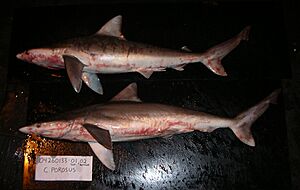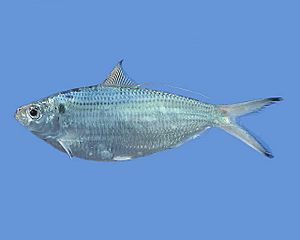Smalltail shark facts for kids
Quick facts for kids Smalltail shark |
|
|---|---|
 |
|
| Conservation status | |
| Scientific classification | |
| Genus: |
Carcharhinus
|
| Species: |
porosus
|
 |
|
| Range of the smalltail shark | |
| Synonyms | |
|
Carcharias henlei Müller & Henle, 1839 |
|
The smalltail shark (Carcharhinus porosus) is a type of requiem shark. These sharks are known for living in warm waters. You can find the smalltail shark in the western Atlantic Ocean. Its home stretches from the northern Gulf of Mexico all the way to southern Brazil.
This shark likes to live in shallow waters near the coast. It especially likes muddy areas around estuaries, which are where rivers meet the sea. Smalltail sharks usually swim close to the bottom. They often gather in large groups, with males and females staying in separate areas. This shark is usually slim and grows to about 1.1 meters (3.6 feet) long. It has a long, pointy snout and a wide, triangular first fin on its back. Its body is plain gray, without any special markings on its fins.
Smalltail sharks mostly eat bony fishes like croakers. They also munch on crustaceans (like crabs and shrimp), cephalopods (like squid), and even smaller sharks and rays. Female smalltail sharks give birth to live young, usually two to nine pups at a time. They have babies every two years, after being pregnant for about 12 months. Sadly, these sharks are often caught by accident when people are fishing for other things. Their meat, fins, and oil are used for different products. The number of smalltail sharks has dropped a lot since the 1980s. Because of this, the International Union for Conservation of Nature says it is a critically endangered species.
Contents
Shark Names and Family Tree
An Italian naturalist named Camillo Ranzani first wrote about the smalltail shark in 1839. He called it Carcharias porosus. The name porosus comes from a Greek word meaning "pore." This refers to the clear pores behind the shark's eyes. Later, scientists moved this shark into the Carcharhinus group. In Trinidad, people sometimes call it the "puppy shark."
Scientists are still trying to figure out the exact family tree of the smalltail shark. Some studies suggest it might be related to sharks like the whitecheek shark or the blackspot shark. Other studies, using DNA information, show it might be closer to the daggernose shark or the blacknose shark. There's also a similar shark found in Southeast Asia that hasn't been officially named yet.
What Does a Smalltail Shark Look Like?
The smalltail shark has a slender body and a fairly long, pointed snout. Each nostril has a small, pointy flap. Its large, round eyes have special eyelids called nictitating membranes. You can also see clear pores behind its eyes. The shark's mouth has short grooves at the corners. It has 13 to 15 rows of teeth on each side of both its upper and lower jaws.
- The upper teeth are tall and triangular. They have strong jagged edges.
- The lower teeth are narrower and straighter, with finer jagged edges.
This shark has five short gill slits on each side of its head. Its pectoral fins (the ones on its sides) are small and curved like a sickle. The first fin on its back (dorsal fin) is wide and shaped almost like a triangle. It starts right above the back tips of its pectoral fins. The second dorsal fin is much smaller. There is no ridge of skin between its two dorsal fins. The shark's pelvic fins are small, and its anal fin has a deep notch. Its tail fin is not symmetrical, with a strong lower part and a longer upper part.
The smalltail shark's skin is covered in tiny, tooth-like scales called dermal denticles. These scales usually don't overlap. Each one has three to five ridges. The shark is plain gray on top and whitish underneath. It might have a faint lighter stripe along its sides. Its pectoral, dorsal, and tail fins can be darker at the tips. Smalltail sharks can grow up to 1.5 meters (4.9 feet) long, but they are usually between 0.9 and 1.1 meters (3 to 3.6 feet). Female sharks tend to be larger than males.
Where Do Smalltail Sharks Live?
The smalltail shark lives from the northern Gulf of Mexico down to southern Brazil. It is not found around most Caribbean islands, except for Trinidad and Tobago. The largest number of these sharks live along the northern coast of Brazil. Here, it is the most common shark species.
This shark usually stays close to the bottom in shallow waters. It prefers depths no more than 36 meters (118 feet). Off northern Brazil, the water can have very strong tides. The saltiness of the water changes a lot between the rainy and dry seasons. The water temperature is usually warm, between 25 to 32 degrees Celsius (77 to 90 degrees Fahrenheit). Smalltail sharks really like estuarine areas with muddy bottoms.
Smalltail Shark Life and Habits
Smalltail sharks form large groups where males and females stay separate. Males are usually found in deeper water than females. These sharks mainly eat bony fishes. Their diet includes sea catfish, croakers, jacks, and grunts. They also eat shrimp, crabs, and squid. Older sharks can even eat young sharpnose sharks, hammerhead sharks, and stingrays.
Smalltail sharks are not picky eaters. They eat whatever food is most available in their environment. For example, off northern Brazil, they mostly eat two types of croakers. Younger sharks eat a wider variety of food than adults. Larger sharks might hunt and eat smalltail sharks.
Reproduction and Life Cycle
Like other sharks in its family, the smalltail shark is viviparous. This means the mother carries her babies inside her body. When the baby sharks use up their yolk supply, a special connection like a placenta forms. This connection helps the mother give food to her growing pups.
Females usually have two to nine pups, but typically four to six. They have babies every other year. The more pups a female has, the larger she usually is. The mother is pregnant for about 12 months. Pups are born throughout the year, but most births happen from September to November.
Known places where baby sharks are born and grow up are in shallow, murky waters off northern Brazil and Trinidad. These areas have many bays and estuaries that offer shelter and food. Newborn smalltail sharks are about 30 to 33 centimeters (12 to 13 inches) long. They grow about 7 centimeters (2.8 inches) each year for their first four years. Males and females become ready to have their own babies when they are about six years old. At this age, they are around 70 to 93 centimeters (2.3 to 3 feet) long. After they mature, their growth slows down to about 4 centimeters (1.6 inches) per year. Smalltail sharks can live for at least 12 years.
Smalltail Sharks and Humans
Smalltail sharks are not dangerous to humans. However, they are often caught by accident in fishing nets and on longlines. People fish for them to use their meat, which is sold fresh, frozen, or dried and salted. Their dried fins are also sold for shark fin soup. The oil from their liver and their cartilage are used in medicine. The rest of the shark's body is processed into fishmeal.
In 2006, the IUCN said there wasn't enough information about this shark. But in Trinidad, it's a very important shark for fishing because there are so many of them. Off northern Brazil, many smalltail sharks are caught by fishing boats looking for other fish. In the 1980s, smalltail sharks made up about 43% of the shark and ray catch. Now, that number has dropped to about 17%.
This drop in numbers is likely due to more fishing, many young sharks being caught, and the shark's slow reproduction rate. Because of this, the IUCN now lists the smalltail shark in Brazil as vulnerable. They say it's very important to protect this shark, especially since northern Brazil is where most of them live. Even though the smalltail shark was put on Brazil's list of endangered animals in 2004, fishing for them is still not properly managed.




